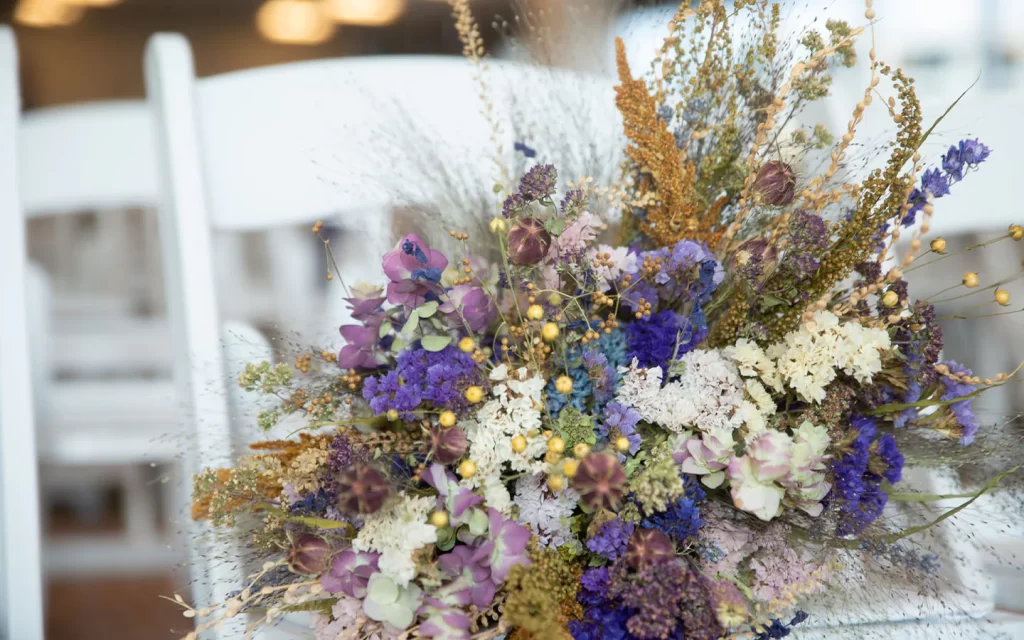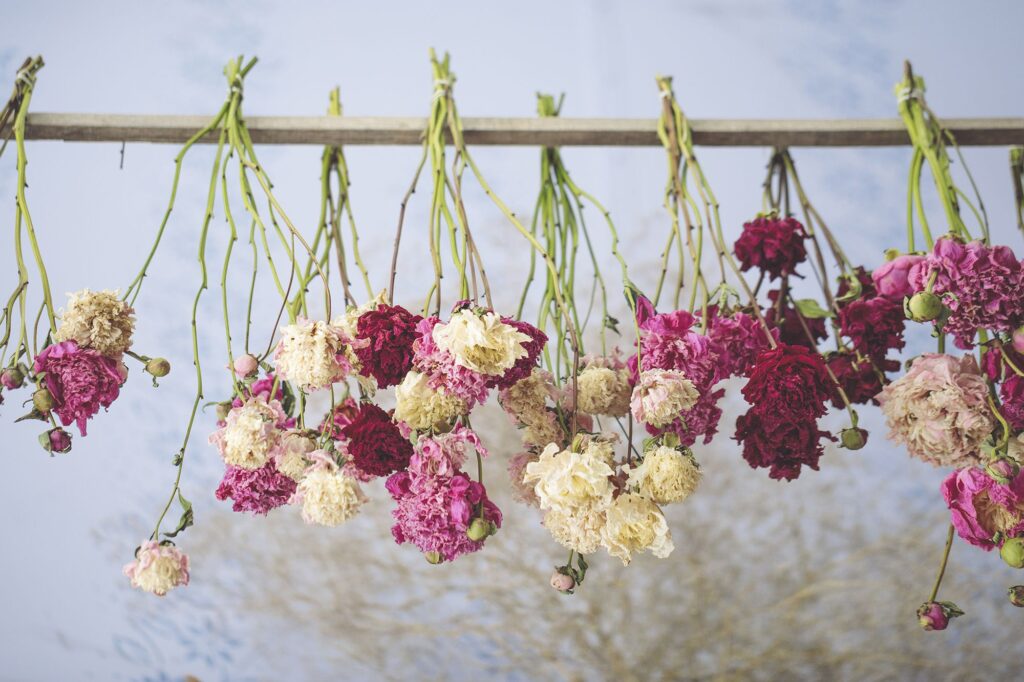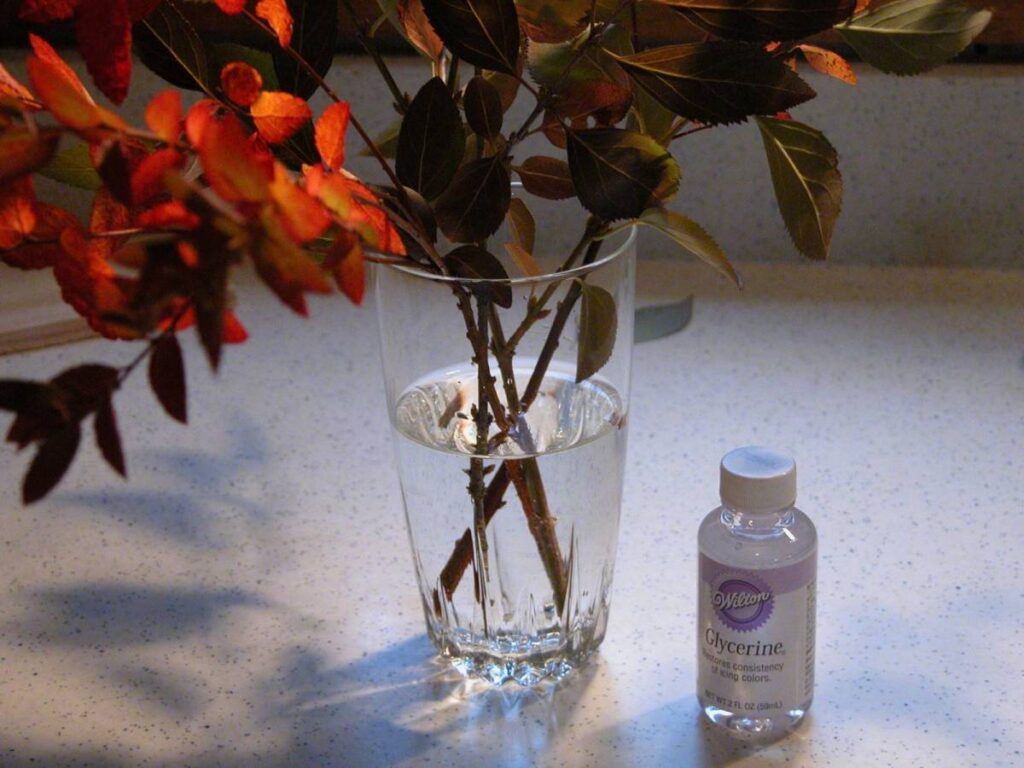Dried and preserved ornamental products offer a wide range of qualities like novelty, longevity, aesthetic properties, flexibility and year round availability. Dry flowers are essential export items both in Indian and International markets and Indian export basket composed of 71% dry flowers which are exported to mainly USA, Japan, Australia, Russia and Europe. The demand for dry flowers is increasing at an impressive rate of 8-10 per cent annually thus offering a lot of opportunities for the Indian entrepreneurs to enter in the global floricultural trade.
The range of dried flowers and other attractive plant parts is quite extensive, namely stems, roots, shoots, buds, flowers, inflorescences, fruits, fruiting shoots, cones, seeds, foliage, bracts, thorns, barks, lichens, fleshy fungi, mosses. A number of flowers respond well to drying techniques such as anemone, zinnia, allium, sweet william, carnation, stock, freesia, narcissus, chrysanthemum, pansy, daffodils, marigold, rose, lilies etc and foliage like ferns, aspidistra, eucalyptus, ivy, laurel .Otherwise this industry exports 500 varieties of flowers to 20 countries and export of dried flowers and plants from India is about Rs. 100 crores.

Harvesting of Materials for Drying
For drying, fresh material is required; faded and old flowers and leaves should be rejected. As per requirement, different flowers can be collected at different stages. The flowers should be cut just as they come to maturity. Flowers harvested at half bloom stage took minimum time for drying. Flowers and foliage should be collected from the field, one or two days after irrigation. The collected materials should be free from surface moisture and dew. Hence it is better to collect the material in the dry season on a sunny day. Flowers or plant parts selected for drying may be sprayed with Dithane Z-78 of Neem based pesticide (0.5%).
Methods of Drying
Several methods are practised for dehydration of flowers and foliage. In these methods, removal of moisture from flowers and foliage is done. Drying is generally done under artificially produced heat and controlled temperature, humidity and airflow. For removal of water from fresh flowers and plant parts, optimum temperature to be determined, otherwise quality of the product will be affected. The different drying methods are discussed below
- Air Drying
- Water Drying
- Sun Drying
- Press Drying
- Embedding
- Oven Drying
- Freeze Drying
- Cryo Drying
- Drying With Glycerine
Air Drying: This is the most common method which is widely used for long lasting seasonal flowers which are crisp in texture. They are hung in an inverted position or kept in an erect manner. Air drying requires a warm clean dark and well ventilated area with low humidity. Flowers may also be spread over blotting sheets/news papers and kept in dark or in the sun. Time taken for drying depends upon room temperature, relative humidity, air flow and moisture content of the flowers. The disadvantage faced by this technique is the shrinkage of petals in most of flowers.

Sun Drying: Plant material is embedded in drying medium (sand) in a container and exposed to the sun daily to facilitate rapid dehydration. In India, open sun drying is followed for drying many flowers.
Water Drying: Some flowers dry well if placed in water. The stems of the flowers are initially placed in a couple of inches of water, then the water is allowed to evaporate and be taken up by the cut flowers. The container and flowers should be in a dry, warm and dark location. Hydrangeas, yarrow, bells-of-Ireland and celosia dry well with this method.
Press Drying: The flowers and leaves are placed between the folds of newspaper sheets or blotting paper. Toensure uniform pressure, flowers for press drying should be spread uniformly on blotting paper. These sheets are kept one above the other and corrugated boards of the same size are placed in between the folded sheets so as to allow the water vapour to escape. It should be given slight pressure for 24 hours and then kept in an electric hot air oven for 24 hours at 40-45oC. The press dried flowers are stored either in sheets at a dry place or in desiccators for future use.Though the flowers and foliages become flat after press drying, yet this material can be used for composing floral craft items like greeting cards, floral designs and other art creations.
Embedding: To overcome the problem of petal shrinking, the flowers are dried in an embedding technique. The flowers or leaves are embedded in a drying medium, namely, silica gel or borax or white sand depending upon the plant material. Embedding in silica gel is perhaps the easiest and the best method of embedded drying of flowers. Metallic or plastic or earthen containers are used for embedding at room temperature in a well ventilated room. About 5 cm layer of desiccant is poured in the bottom of the container and the flower stems are pushed into the medium. Flowers are covered and kept at room temperature. This method takes long time but give good drying without altering shape and appearance of the flower. To enhance dehydration, the preparation set is kept under the afternoon sun. After dehydration, the containers are tilted for removing the desiccants over and around the flowers. The dried flowers are either picked up by hand or by tweezers.
Oven Drying: To get the superior product, oven drying is the best method. The drying time can be reduced if the stalks are kept in an oven at an appropriate temperature. The embedded plant material is kept in the hot air oven at a controlled temperature for an appropriate time. But care must be taken in the drying temperature and duration of drying. Electrically operated hot air oven at a controlled temperature of 40-50oC c is usually used for drying flowers in an embedded condition.
Freeze Drying: Freeze drying is used for preserving flowers and is particularly popular for wedding bouquet preservation. Petals can also be freeze dried and used for decorations at weddings, dinner parties and other occasions, for decorating cakes and scattering on tables etc. Freeze drying flowers uses a process called lyophilization to lower the temperature of the flowers to below freezing, and then a high-pressure vacuum is applied to extract the water in the form of vapour. The vapour collects on a condensing surface outside the chamber, turns back to ice and is removed. Finally, a gradual temperature rise extracts all remaining ‘bound’ moisture from the flowers. This process retains the original shape and structure and preserves the flowers.
Cryo Drying: The fully open flowers are cut into a uniform 15cm length and placed in vials so that the basal 5 cm is immersed in solution of glycrerine, clove oil, ethylene glycol, dimethyl sulphoxide and wetting agent. After that the flower stems are recut to 5cm in length and placed in a freezing temperature at -80oC for 12 hours. Then the flowers are immediately placed in a freeze dryer at 20oC under a vacuum of less than 100 microns for 7 days. A minimum of 7 days is required for the flower and stem tissues to be totally dry.
Drying with Glycerine: In this method, the angular cut stem ends of berries and leafy material can be dried with their lower ends dipped in a mixture of 1:4 glycerine and water for 3 to 6 days for soft stems and 6 weeks for woody stems.Many types of foliage have been successfully preserved by either immersing leaves or placing crushed stems in a 33 per cent glycerol solution.Being an osmotic agent, glycerine replaces the water content of the tissues. After treating with glycerine, the plant material can be microwaved.

Special Preservation Techniques
Skeletonizing: This treatment eliminates all tissues but the “skeleton” or veins of leaves. Skeletonized leaves lend an interesting, lacy appearance to dried arrangements. Heavy-textured leaves are the best selects for this method of preservation. Leaves are boiled for 40 minutes in 1-quart water and 2 tablespoons of lye and rinsed in cold water and scraped or brushed the green pulp from the leaves without destroying the network of veins. To lighten the color of the leaf skeletons, immersed in a 1-quart water and 2 tablespoon household bleach solution for 2 hours followed by rinsing anddrying.
Bleaching:Bleached ornamental plant material provides a striking appearance when arranged with dried or dyed flowers. Bleaching also permits the use of dyes for colouring. Oxidative (Hypochlorite, chlorite and peroxide) and reductive bleaching chemicals (Sulphite and borohydride) are used for bleaching ornamental flowers and foliage. Sodium chlorite is an excellent bleaching agent because it is relatively selective for lignin without damaging fibre. In reductive bleaches, hydrosulphites (Sodium or zinc hydrosulphite) are cheap and have maximum bleaching power. After bleaching with oxidative or reductive chemicals, yellowing of the plant materials is the main problem. To avoid yellowing, multi -step bleaching i.e., alternating oxidative bleach with a reductive bleach create products with less yellowing. A final wash in a 2 % solution of barium hydroxide, calcium hydroxide, sodium bicarbonate or aluminium sulphate prevents yellowing.
Sulphuring : It is used to prevent enzymatic colour change. Traditionally, sulphur granules have been burnt for about 2 hours in a closed chamber along with dry flowers. It is very toxic and therefore, it is advised to check relevant safety instructions.
CONCLUSION
In conclusion, dry flowers offer timeless beauty, longevity, and versatility, making them an enchanting choice for various occasions and decor styles. Whether adorning a space or preserving cherished memories, their delicate charm continues to captivate admirers, infusing spaces with a sense of nostalgia and elegance that endures beyond the passage of time.
Author : Suvalaxmi Palei, Meenakshi Badu, Kalyani Pradhan, Lopamudra Jena
Ashesh Chand, Ipsita dash, Jagnyaseni Behera, Sibani Khatua, Sudeshna Pasayat
Faculty of Agriculture, Sri Sri University,Cuttack-754006
